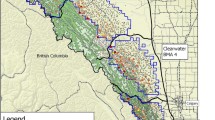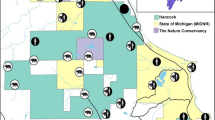Abstract
Rocky Mountain National Park (RMNP) is home to a low-density black bear (Ursus americanus) population that exists at >2,400 m with a very limited growing season. A previous study (1984–1991) found bear densities among the lowest reported (1.37–1.52 bears/100 km2). Because of concerns of viability of this small population, we assessed population size and density of black bears from 2003 to 2006 to determine the current status of RMNP’s bear population. We used three approaches to estimate population size and density: (1) minimum number known, (2) occupancy modeling, and (3) catch per unit effort (CPUE). We used information from capture and remote-triggered cameras, as well as visitor information, to derive a minimum known population estimate of 20–24 individuals and a median density estimate of 1.35 bears/100 km2. Bear occupancy was estimated at 0.46 (SE = 0.11), with occupancy positively influenced by lodgepole pine stands, non-vegetated areas, and patch density but negatively influenced by mixed conifer stands. We combined the occupancy estimate with mean home-range size and overlap for bears in RMNP to derive a density estimate of 1.44 bears/100 km2. We also related CPUE to density estimates for eight low-density black bear populations to estimate density in RMNP; this estimate (1.03 bears/100 km2) was comparable to the occupancy estimate and suggests that this approach may be useful for future population monitoring. The use of corroborative techniques for assessing population size of a low-density black bear population was effective and should be considered for similar low-density wildlife populations.


Similar content being viewed by others
References
Agresti A (1996) An introduction to categorical data analysis. Wiley, New York
Arnold TW (2010) Uninformative parameters and model selection using Akaike’s information criterion. J Wildl Manage 74:1175–1178
Augeri DM, Reading RP, Fisher M, Chivers DJ, Royle JA (2006) Good estimates of density: a response to Garshelis and McLellan. Int Bear News 15:8–11
Baldwin RA (2008) Population demographics, habitat utilization, critical habitats, and condition of black bears in Rocky Mountain National Park. Ph.D. dissertation, New Mexico State University, Las Cruces
Baldwin RA, Bender LC (2008a) Den-site characteristics of black bears in Rocky Mountain National Park, Colorado. J Wildl Manage 72:1717–1724
Baldwin RA, Bender LC (2008b) Distribution, occupancy, and habitat correlates of American martens (Martes americana) in Rocky Mountain National Park, Colorado. J Mammal 89:419–427
Baldwin RA, Bender LC (2009a) Foods and nutritional components of diets of black bear in Rocky Mountain National Park, Colorado. Can J Zool 87:1000–1008
Baldwin RA, Bender LC (2009b) Survival and productivity of a low-density black bear population in Rocky Mountain National Park, Colorado. Hum–Wildl Confl 3:271–281
Baldwin RA, Bender LC (2010) Denning chronology of black bears in eastern Rocky Mountain National Park, Colorado. West N Am Nat 70:48–54
Beck TDI (1991) Black bears of west-central Colorado. Technical publication number 39, Colorado Division of Wildlife, Ft. Collins
Beck TDI (1997) Development of black bear inventory techniques. Federal Aid Progress Report W-153-R-10, WP5A, J2, Colorado Division of Wildlife, Fort Collins
Bender LC, Roloff GJ, Haufler JB (1996) Evaluating confidence intervals for habitat suitability models. Wildl Soc Bull 24:347–352
Bowman JL, Chamberlain MJ, Leopold BD, Jacobson HA (1996) An evaluation of two censusing techniques to estimate black bear population size on White River National Wildlife Refuge, Arkansas. Proc Annu Conf Southeast Assoc Fish Wildl Agencies 50:614–621
Brown JH (2004) Challenges in estimating size and conservation of black bear in west-central Florida. Master’s thesis, University of Kentucky, Lexington
Burnham KP, Anderson DR (2002) Model selection and multimodel inference: a practical information-theoretic approach. Springer, New York
Clark JD, Smith KG (1994) A demographic comparison of two black bear populations in the interior highlands of Arkansas. Wildl Soc Bull 22:593–603
Costello CM, Jones DE, Green-Hammond KA, Inman RM, Inman KH, Thompson BC, Deitner RA, Quigley HB (2001) A study of black bear ecology in New Mexico with models for population dynamics and habitat suitability. Final report, Federal Aid in Wildlife Restoration Project W-131-R. New Mexico Department of Game and Fish, Santa Fe
Cunningham SC, Ballard WB (2004) Effects of wildfire on black bear demographics in central Arizona. Wildl Soc Bull 32:928–937
Elkie PC, Rempel RS, Carr AP (1999) Patch analyst user’s manual. Technical manual TM-002, Northwest Science and Technology. Ontario Ministry of Natural Resources, Thunder Bay
Elowe KD (1987) Factors affecting black bear reproductive success and cub survival in Massachusetts. Ph.D. dissertation, University of Massachusetts, Amherst
Frost HC (1990) Population and reproductive characteristics of black bears on an isolated mountain in southeastern Utah. Master’s thesis, Brigham Young University, Provo
Grogan RG, Lindzey FG (1999) Estimating population size of a low-density black bear population using capture–resight. Ursus 11:117–122
Gu W, Swihart RK (2004) Absent or undetected? Effects of non-detection of species occurrence on wildlife-habitat models. Biol Conserv 116:195–203
Harter WH, III (2001) Biology of the black bear in the northern coastal plain of South Carolina. Master’s thesis, Clemson University, Clemson
Jennelle CS, Runge MC, MacKenzie DI (2002) The use of photographic rates to estimate densities of tigers and other cryptic mammals: a comment on misleading conclusions. Anim Conserv 5:119–120
Karanth KU, Nichols JD (1998) Estimation of tiger densities in India using photographic captures and recaptures. Ecology 79:2852–2862
Kasworm WF, Manley T (1988) Grizzly bear and black bear ecology in the Cabinet Mountains of Northwest Montana. Montana Department of Fish, Wildlife, and Parks, Helena
Lindzey FG, Meslow EC (1977) Population characteristics of black bears on an island in Washington. J Wildl Manage 41:408–412
Linke J, Franklin SE, Huettmann F, Stenhouse GB (2005) Seismic cutlines, changing landscape metrics and grizzly bear landscape use in Alberta. Landsc Ecol 20:811–826
MacKenzie DI (2006) Modeling the probability of resource use: the effect of, and dealing with, detecting a species imperfectly. J Wildl Manage 70:367–374
MacKenzie DI, Bailey LL (2004) Assessing the fit of site occupancy models. J Agric Biol Environ Stat 9:300–318
MacKenzie DI, Nichols JD (2004) Occupancy as a surrogate for abundance estimation. Anim Biodivers Conserv 27:461–467
MacKenzie DI, Nichols JD, Lachman GB, Droege S, Royle JA, Langtimm CA (2002) Estimating site occupancy rates when detection probabilities are less than one. Ecology 83:2248–2255
MacKenzie DI, Nichols JD, Royle JA, Pollock KH, Bailey LL, Hines JE (2006) Occupancy estimation and modeling: inferring patterns and dynamics of species occurrence. Academic, San Diego
Martorello DA, Eason TH, Pelton MR (2001) A sighting technique using cameras to estimate population size of black bears. Wildl Soc Bull 29:560–567
McCutchen HE (1990) Cryptic behavior of black bears (Ursus americanus) in Rocky Mountain National Park, Colorado. Int Conference Bear Res Manage 8:65–72
McCutchen HE (1993) Ecology of high mountain black bear population in relation to land use at Rocky Mountain NP. Park Sci 13:25–27
Miller SD, Becker EF, Ballard WB (1987) Black and brown bear density estimates using modified capture–recapture techniques in Alaska. Int Conference Bear Res Manage 7:23–35
Miller SD, White GC, Sellers RA, Reynolds HV, Schoen JW, Titus K, Barnes VG Jr, Smith TB, Nelson RR, Ballard WB, Schwartz CC (1997) Brown and black bear density estimation in Alaska using radiotelemetry and replicated mark–resight techniques. Wildl Monogr 133:1–55
Nagelkerke NJD (1991) A note on a general definition of the coefficient of determination. Biometrika 78:691–692
National Park Service (1988) Management policies. U.S. Department of the Interior, Washington, DC
Nichols JD, Williams BK (2006) Monitoring for conservation. Trends Ecol Evol 21:668–673
Noyce KV, Garshelis DL, Coy PL (2001) Differential vulnerability of black bears to trap and camera sampling and resulting biases in mark–recapture estimates. Ursus 12:211–226
O’Connell AF Jr, Talancy NW, Bailey LL, Sauer JR, Cook R, Gilbert AT (2006) Estimating site occupancy and detection probability parameters for meso- and large mammals in a coastal ecosystem. J Wildl Manage 70:1625–1633
Oli MK, Jacobson HA, Leopold BD (2002) Pattern of space use by female black bears in the White River National Wildlife Refuge, Arkansas, USA. J Nat Conserv 10:87–93
Orlando MA (2003) The ecology and behavior of an isolated black bear population in west central Florida. Master’s thesis, University of Kentucky, Lexington
Pagano AM, Arnold TW (2009) Detection probabilities for ground-based breeding waterfowl surveys. J Wildl Manage 73:392–398
Pelton MR (2003) Black bear (Ursus americanus). In: Feldhamer GA, Thompson BC, Chapman JA (eds) Wild mammals of North America: biology, management, and conservation, 2nd edn. Johns Hopkins University Press, Baltimore, pp 547–555
Romain-Bondi KA, Wielgus RB, Waits L, Kasworm WF, Austin M, Wakkinen W (2004) Density and population size estimates for North Cascade grizzly bears using DNA hair-sampling techniques. Biol Conserv 117:417–428
Seber GAF (1982) The estimation of animal abundance and related parameters. Charles Griffin and Company, London
Zar JH (1999) Biostatistical analysis, 4th edn. Prentice Hall, Upper Saddle River
Acknowledgments
Research was funded by Rocky Mountain National Park and the New Mexico State University, Agricultural Experiment Station. Thanks are extended to K. Boykin, A. Ernst, and S. Schrader for assistance with GIS questions. S. Graham, B. Hoenes, M. Levine, L. Polson, M. Polson, and many other RMNP volunteers provided valuable field assistance.
Author information
Authors and Affiliations
Corresponding author
Additional information
Communicated by C. Gortázar
Rights and permissions
About this article
Cite this article
Baldwin, R.A., Bender, L.C. Estimating population size and density of a low-density population of black bears in Rocky Mountain National Park, Colorado. Eur J Wildl Res 58, 557–566 (2012). https://doi.org/10.1007/s10344-011-0605-z
Received:
Revised:
Accepted:
Published:
Issue Date:
DOI: https://doi.org/10.1007/s10344-011-0605-z




